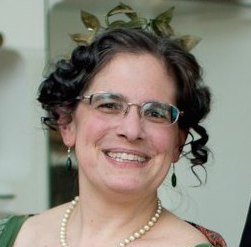I suppose this could be considered the next post in a very stretched-out series covering American “gavotte” variations for the late nineteenth century schottische; my first post on the topic appeared almost ten years ago. I’m glad I put this one off a bit, however, since my experience since then with reconstructing, dancing, and teaching rackets has given me a better appreciation for how this “gavotte” variation works. Essentially, it’s two halves: a slow schottische turn and a racket. It’s kind of beautiful.
The Schottische Gavotte, like so many other variations, is found in M. B. Gilbert’s book of couple dances, Round Dancing (Portland, Maine, 1890) and in G. W. Lopp’s La Danse (Paris, 1903). Gilbert does not attribute it. Lopp attributes it to Gilbert. Lopp also lists it as 3/4, but since it is under schottische, notated like a schottische (in 4), and has a given metronome speed of 76 beats per minute in schottische time, I think that 3/4 is an error and it is intended to be in 4/4. Other than that, the two descriptions agree nicely and the reconstruction is quite simple and straightforward. The gentleman starts with the left foot, the lady with the right.
Schottische Gavotte (eight measures of schottische 4/4 time)
1234 Slide-close-slide-hop (raising free foot in third behind)
1234 Repeat, leading with second foot
1&2&3..4& Slide-close-slide-close-slide-cut-cut
1&2&3..4 Slide-close-slide-close-slide-close
The sequence then repeats starting with the second foot (his right, her left) over elbows.
The first two measures are the “slow polka” of the early schottische. It’s not clear from either Gilbert or Lopp whether they actually turn; they could just be danced at a gentle zigzag along the line of dance.
The third and fourth measures are the three-slide racket as well as being in the “gavotte” rhythm characteristic of other gavotte schottisches and the American Gavotte, which may or may not be a schottische. What makes them a racket? The “cut-cut” at the end, switching direction. I didn’t really register this in the other gavotte variations because none of them had a change of lead foot. The racket element disappears when steps are done only to one side. (I recommend close study of this post for how to perform the racket measures.)
Rackets being rackets, and not necessarily turning, the direction of travel in the third and fourth measures above is also unclear. The cut-cut could be used to turn the dancers halfway, so that the fourth measure is “over elbows”. They could also be done traveling on the diagonals, with the gentleman going forward and the lady back, or possibly vice-versa.
Gilbert failing to specify turning doesn’t necessarily mean that a dance didn’t turn, but given the history of the schottische (not turning in the first part) and the racket (not turning at all), I think doing the Schottische Gavotte entirely as a series of zigzags along the line of dance would be perfectly appropriate. And if one wanted to expand to the full range of nineteenth-century improvisation in couple dances, each of the two parts of this sequence, independently, could also be danced turning to the right (natural turn), or even turning to the left (reverse turn). Have fun!


Leave a Reply